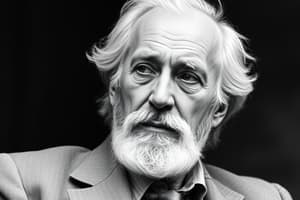Podcast
Questions and Answers
What is primary deviance?
What is primary deviance?
- When a person accepts their deviant behavior and continues to engage in it
- The process of labeling someone as deviant
- Behavior that conforms to social norms
- The initial act of rule breaking (correct)
What is the result of secondary deviance?
What is the result of secondary deviance?
- The individual's behavior is normalized by their reference group
- The person continues to engage in deviant behavior and accepts their new identity (correct)
- The person becomes less dependent on institutions
- The person is freed from social pressures to conform
What is the relationship between deviance and conformity?
What is the relationship between deviance and conformity?
- Deviance is the absence of conformity
- Deviance and conformity are necessarily linked together (correct)
- Conformity is a type of deviance
- Deviance and conformity are mutually exclusive
What is the term for when an individual's behavior is normalized by their reference group?
What is the term for when an individual's behavior is normalized by their reference group?
Which philosopher noted the importance of categorical distinctions between right and wrong?
Which philosopher noted the importance of categorical distinctions between right and wrong?
What is an example of deviant attributes, as described by Thomas Wolfe?
What is an example of deviant attributes, as described by Thomas Wolfe?
What is the outcome of being labeled as deviant?
What is the outcome of being labeled as deviant?
What is deviance, in relation to social norms?
What is deviance, in relation to social norms?
What is a master status?
What is a master status?
What is the primary function of status categories?
What is the primary function of status categories?
According to strain theory, what is the cause of deviant behavior?
According to strain theory, what is the cause of deviant behavior?
What is differential association theory?
What is differential association theory?
What is the role of social power in deviance?
What is the role of social power in deviance?
How does deviance relate to cultural values and norms?
How does deviance relate to cultural values and norms?
What is the result of responding to deviance?
What is the result of responding to deviance?
Why do people from lower classes resort to illegal or unethical tactics?
Why do people from lower classes resort to illegal or unethical tactics?
What does Rational Choice Theory explain in the context of social work?
What does Rational Choice Theory explain in the context of social work?
Which theory explains how power disparities affect individuals and societies?
Which theory explains how power disparities affect individuals and societies?
What is the basis of relationships according to Social Exchange Theory?
What is the basis of relationships according to Social Exchange Theory?
What is the focus of Cognitive Behavioral Therapy?
What is the focus of Cognitive Behavioral Therapy?
Which practice model is employed for clients in crisis and trauma?
Which practice model is employed for clients in crisis and trauma?
What is the main idea behind Transpersonal Theory?
What is the main idea behind Transpersonal Theory?
What is the goal of social workers using Rational Choice Theory?
What is the goal of social workers using Rational Choice Theory?
What is Identity Achievement, according to the given content?
What is Identity Achievement, according to the given content?
What happens when the hazards outweigh the possible advantages in a relationship according to Social Exchange Theory?
What happens when the hazards outweigh the possible advantages in a relationship according to Social Exchange Theory?
What is the Unity of Personality principle proposing?
What is the Unity of Personality principle proposing?
What is the Organ of Inferiority, according to Alfred Adler?
What is the Organ of Inferiority, according to Alfred Adler?
What is the Striving for Superiority, according to the given content?
What is the Striving for Superiority, according to the given content?
What is the Inferiority Complex, according to the given content?
What is the Inferiority Complex, according to the given content?
What is the Style of Life, according to the given content?
What is the Style of Life, according to the given content?
What is the age at which a person's lifestyle is said to crystallize, according to the given content?
What is the age at which a person's lifestyle is said to crystallize, according to the given content?
What is Fictional Finalism, according to the given content?
What is Fictional Finalism, according to the given content?
What is the collective unconscious according to Carl Jung?
What is the collective unconscious according to Carl Jung?
What is the term for the 12 inherited patterns of thought and behavior?
What is the term for the 12 inherited patterns of thought and behavior?
What is the persona, according to Carl Jung?
What is the persona, according to Carl Jung?
What is the syzygy, according to Carl Jung?
What is the syzygy, according to Carl Jung?
What is the shadow, according to Carl Jung?
What is the shadow, according to Carl Jung?
What is the ultimate goal of the self, according to Carl Jung?
What is the ultimate goal of the self, according to Carl Jung?
What is the principle of equivalence, according to Carl Jung?
What is the principle of equivalence, according to Carl Jung?
What is the term for the forward movement of libidinal energy, according to Carl Jung?
What is the term for the forward movement of libidinal energy, according to Carl Jung?
Flashcards are hidden until you start studying
Study Notes
Collective Unconscious and Archetypes
- Collective unconscious: collective experiences during a revolutionary past or the accumulation of ancestral experience
- Archetype: inherited predisposition to respond to certain aspects of the world
- 12 archetypes: Innocent, Everyman, Hero, Outlaw, Explorer, Creator, Ruler, Magician, Lover, Caregiver, Jester, and Sage
Persona and Syzygy
- Persona: one’s need to play a role in society; “one’s public self”
- Syzygy: the pair of Anima (female component of a male) and Animus (male component of a female)
Shadow and the Self
- Shadow: darkest deepest part of the psyche; inherited from pre-human ancestor; contains raw animal instinct and desire
- The Self: the whole of psyche and its potential; its goal is wholeness and harmony, thus the self-actualization
- Mandala: a symbol of self, which means circle
Individuation and Synchronicity
- Individuation: the differentiation of the parts of the psyche or personality; process of finding harmony between all components of the psyche and embracing one’s individuality
- Synchronicity: or meaningful coincidence is when one fantasizes an event, and it occurs
Progression and Regression
- Progression: forward movement of libidinal energy
- Regression: backward movement of libidinal energy
Dynamics of Personality
- Principle of Equivalence: if a particular value weakens, the sum of energy represented by the value will not be lost, but it will reappear in a new value
- Principle of Entropy: if two values are of unequal strength, energy will tend to pass from the strongest to the weaker value until balance is reached
Individual Psychology (Alfred Adler)
- Described unconsciousness as a temporary state of unawareness
- Each person can create their own personalities with conscious intent to achieve their goals
- Unity of Personality: principle proposing that individual is not internally divided nor driven by conflicting internal forces; each aspect of personality is pointing at the same direction and is subordinated to the individual’s style of life
Structure of Personality
- Organ of Inferiority: people are more vulnerable to disease in organs that are less developed, or inferior to other organs
- Feelings of Inferiority: children start life with feeling inferior because they are completely dependent; feeling of being weak, inferior, and impotent stimulates the desire for power
- Striving for Superiority: is a fundamental fact of life; an innate need from the time of birth
- Style of Life: means by which an individual attempts to gain superiority; one’s lifestyle crystallizes at the age of 4 or 5
- Fictional Finalism: Fictional future goal which a person aspires for
- Safeguarding Techniques: protective devices that enable a person protect their self-image and maintain their style of life; Excuses, Aggression, Withdrawal
Deviance and Deviant Behavior
- Primary Deviance: refers to the initial act of rule breaking; behavior that does not conform to the social norms, but the behavior might be temporary, fleeting, exploratory, trivial, or especially, concealed from the most differently
- Secondary Deviance: occurs when a person who has been labeled a deviant accepts that new identity and continues the deviant behavior
- Elements useful in Understanding Deviance
- Deviance as negative quality
- Deviance and conformity are necessarily linked together; each implies the existence of the other
- Good cannot exist without reference to evil, its opposite
- Theoretical Foundations
- Strain Theory (Robert K. Merton)
- Differential Association Theory
- Rational Choice Theory
- Conflict Theory
- Social Exchange Theory
- Transpersonal Theory
Five Major Practice Models in Social Work
-
- Cognitive Behavioral Therapy
-
- Crisis Intervention Model
-
- (No information provided for this point)
-
- (No information provided for this point)
-
- (No information provided for this point)
Studying That Suits You
Use AI to generate personalized quizzes and flashcards to suit your learning preferences.




